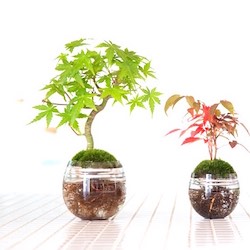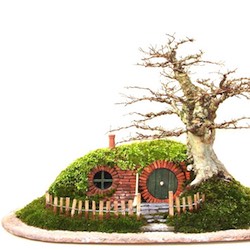The mountain is particularly favorable for the collection of stones for suiseki. However, you have to know how to spot the stones, know where they hide, collect them without damaging them, and then reveal their beauty. In this article we show you the process.
By Sami Amdouni - Suiseki is the perfect representation of the beauty of mother nature. Each stone is unique and can provide a feeling of inner well-being and tranquility. Going out to collect Suiseki stones can quickly become an oxygen bubble to escape the stress of the city and work. The mountain is a place known to contain beautiful discoveries. Be as close as possible to nature, landscapes of high mountains, lakes and rivers, flowers, wild horses, raptors soaring in the sky and the whistling of marmots.

The mountain offers us beautiful stones. The main thing is to know how to see them, because they are hidden most often.
Collecting Suiseki stones in nature
It is possible to find stones in the mountains, in forests, rivers, streams, on the sea board, anywhere really. But certain places are more favorable than others.
The equipment
To collect stones, it is necessary to have a good backpack, with a good frame and protection for your back. Indeed, some stones can be heavy and have sharp edges. Do not forget to pack a pair of gloves, an ice ax to dig and turn the stones, a wire brush to do an initial cleaning on site and keep something to pack the stones to prevent them from knocking together and being damaged during transport.
Dig up the stones
Once you are in the mountains, it's all about looking, browsing around to find the treasure you are looking for. The stones are often buried - only one piece protrudes above the surface - or it lies upside down. If you find a potential stone, use your ice ax to clear the circumference of the stone, taking care not to damage it. We have to turn over or take out several dozen stones before even hoping to find one with beautiful characteristics, some potential or something to it we simply like.
Clean on site
The stones are often covered with a very hard gangue (dirt), which means having to imagine them through this deposit. It is only after some basic cleaning that you can appreciate the beauty of the collected stone. Obviously, sometimes we are disappointed when a stone has defects. Ensuring that the stone is not broken or cracked is also essential. Furthermore, even if it is no longer visible afterwards, the underside of the stone is important, because the more it is damaged, the more difficult the daiza (carved wooden base) will be.
On site, I therefore advise you to wet the stone and start cleaning it using a wire brush, or a knife, which will allow you not only to lighten the stone during transport, but also to verify that it interests you.

Stone A. Most often, a gangue surrounds the stone.

Stone B. You have to be able to guess the stone behind its protection. On site, we wet the stone and we clean it a bit to judge its quality.
Deep cleaning
Once back at home, deep cleaning can begin. It is necessary to work outside in a ventilated place. Before brushing, we first wet the stone to reduce the production of dust. The wire brush does not scratch the mineral because it is very hard. However, I advise you to test on an invisible part to make sure you don't damage the stone. We hold the stone very firmly to clean it with an electric wire brush: the speed of rotation of the tool could cause the stone to fly and break it, or could injure us. At this stage, the dust is very fine, so wearing a mask is strongly recommended.
Care is taken to remove the deposit from the gangue. For stones that are very difficult to clean, it may be necessary to soak for several days in water. It is also possible to use dentist equipment to scrape the thinnest parts. The wire brush can leave a deposit on the stone, making it too shiny and artificial. It is important to clean with an abrasive brush to remove any traces of metal. Once cleaned, the stone is washed and rubbed with a microfiber cloth. The stone thus cleaned awaits its daiza, then to be well presented, at home or in exhibition.
Cleaning equipment
A column drill with metal brushes and nylon abrasive brushes, a hand tool type Dremel with smaller metal brushes is necessary to access the narrowest parts of the stone. It is essential to not neglect protections such as gloves (metal brushes are very abrasive!), A dust mask and protective glasses against projections.

A column drill with metal brushes to clean the stone.

The beauty of the stone gradually appears under the rotary tool.

The cleaned B stone reveals a shape, which each one interprets in his own way.
Designing a Daiza for the stone
Each stone has its base: the daiza. As a pot highlights a tree, the daiza highlights the stone. To present a stone, you need a wooden base, a daiza in Japanese. With a minimum of tools, we can start manufacturing this base.
The daiza is a carved wooden base, custom-made to accommodate and enhance a stone. It helps stabilize it in a chosen orientation to reveal its potential. Elegant, but discreet, the daiza should not be the main element of the presentation. Ideally, each stone should have its own daiza, even if it is intended to be placed in a suiban or doban (ceramic tray). In winter, avoid exposing stones in a suiban or a doban, because this kind of presentation gives a feeling of freshness and is much appreciated during periods when temperatures are higher. The choice of wood is very important for a daiza, because you must avoid soft wood. Fine-grained woods are preferred to obtain a beautiful finish after sanding. Here I used cherry.

The wooden base, the daiza in Japanese, on which this stone is placed was custom made.
The equipment needed
A wooden board
A pencil or pen
Gouges
A Dremel-type tool machine with wood cutters
A scroll saw or a band saw
Sandpaper n ° 120, 180, 240, 300, or even thinner.
Wood stain
Wood varnish
A protective mask
protective glasses
Gloves
Carbon paper.

The necessary equipment.

To define the inclination of the stone in its base, wooden wedges are placed, because the underside of the stone is not flat. It also gives an indication of the depth of the daiza.

It is important that the chosen wooden board is well planed, with a flat surface on its back. We start by digging the wood using a gouge to anchor the right part, and being able to trace the outline of the stone with a pencil, then with the gouge. Do not hesitate to go deep into the wood.

We present the stone on its base and we repeat the previous step until the stone takes place perfectly in its base.

We use carbon paper to adjust the stone so that it no longer moves in its base. We can see the traces left by the carbon paper in contact with the stone. Using a power tool, dig the marked parts and repeat the operation until the stone is well installed.

We trace the outline of the daiza, then cut it using a band saw or scroll. Then reduce the height of the base and trace the feet. Using the carving tools, cut the feet to a height of a few millimeters.

We dug the feet and a small wall around the perimeter of the base, which corresponds to the different heights of the stone.

You can roughen the Dremel sanding with small abrasive rollers. But the finishing must be done by hand and with sanding paper, from the coarsest grain to the finest. This step is very important for the final result: the surface must be as silky as possible. The daiza must stand on all feet, so that its flatness is correct. To do this, simply rub it on an abrasive sheet until all the feet are the same height.

We plant the daiza on a stick to facilitate the painting: five parts of golden walnut for one of mahogany.

Here, we passed three layers of colour.
We kindly thank Esprit Bonsai and the author Sami Amdouni.





